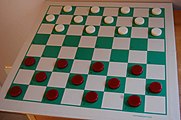Checkerboard

A checkerboard (American English) or chequerboard (British English; see spelling differences) is a board of checkered pattern on which checkers (also known as English draughts) is played.[1] Most commonly, it consists of 64 squares (8×8) of alternating dark and light color, typically green and buff (official tournaments), black and red (consumer commercial), or black and white (printed diagrams). An 8×8 checkerboard is used to play many other games, including chess, whereby it is known as a chessboard. Other rectangular square-tiled boards are also often called checkerboards.
Games and puzzles using checkerboards[]

Martin Gardner featured puzzles based on checkerboards in his November 1962 Mathematical Games column in Scientific American. A square checkerboard with an alternating pattern is used for games including:
- Amazons
- Chapayev
- Chess and some of its variants (see chessboard)
- Czech draughts
- Draughts, also known as checkers
- Frisian draughts
- Gounki
- International draughts
- Italian draughts
- Lines of Action
- Pool checkers
- Russian checkers
The following games require an 8×8 board and are sometimes played on a chessboard.
- Arimaa
- Breakthrough
- Crossings
- Mak-yek
- Makruk
- Martian Chess
Mathematical description[]
Given a matrix with rows and columns, a function ,
or, alternatively,
The element is black and represents the lower left corner of the board.
Gallery[]

An empty 8×8 checkerboard

An empty 8×8 checkerboard diagram

The opening setup of international draughts, which uses a 10×10 checkerboard

English draughts tournament standard
See also[]
References[]
| Look up checkerboard in Wiktionary, the free dictionary. |
- ^ Weisstein, Eric W. "Checkerboard". mathworld.wolfram.com.
- Draughts
- Game equipment









